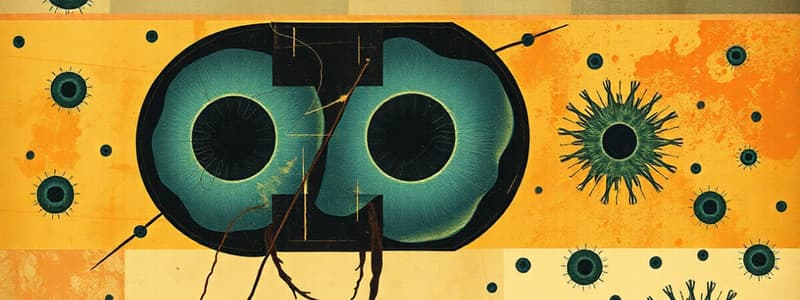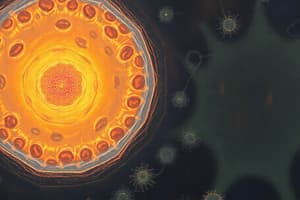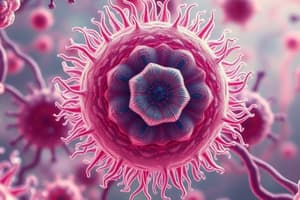Podcast
Questions and Answers
Which of the following is NOT a tenet of the cell theory?
Which of the following is NOT a tenet of the cell theory?
- Cells can spontaneously generate from non-living matter. (correct)
- All living things are composed of cells.
- New cells are produced from existing cells.
- Cells are the basic units of structure and function in living things.
Prokaryotic cells contain membrane-bound organelles such as a nucleus.
Prokaryotic cells contain membrane-bound organelles such as a nucleus.
False (B)
What is the primary function of the cell membrane?
What is the primary function of the cell membrane?
regulating the movement of substances in and out of the cell
The powerhouse of the cell, responsible for generating energy through cellular respiration, is the ________.
The powerhouse of the cell, responsible for generating energy through cellular respiration, is the ________.
Match the cell structure with its primary function:
Match the cell structure with its primary function:
Which structure is found in plant cells but NOT in animal cells?
Which structure is found in plant cells but NOT in animal cells?
Chloroplasts are the organelles responsible for cellular respiration in plant cells.
Chloroplasts are the organelles responsible for cellular respiration in plant cells.
What is the main function of vacuoles in plant cells?
What is the main function of vacuoles in plant cells?
In the organization of living things, cells are organized into ________.
In the organization of living things, cells are organized into ________.
Match the level of organization with its components:
Match the level of organization with its components:
Which process describes the movement of molecules from an area of higher concentration to an area of lower concentration?
Which process describes the movement of molecules from an area of higher concentration to an area of lower concentration?
Osmosis is the diffusion of any molecule across a selectively permeable membrane.
Osmosis is the diffusion of any molecule across a selectively permeable membrane.
Specifically, what molecule moves from an area of high concentration to low concentration during osmosis?
Specifically, what molecule moves from an area of high concentration to low concentration during osmosis?
Photosynthesis converts light energy into chemical energy in the form of ________.
Photosynthesis converts light energy into chemical energy in the form of ________.
Match the reactants and products of photosynthesis:
Match the reactants and products of photosynthesis:
Which organelle is the site of photosynthesis in plant cells?
Which organelle is the site of photosynthesis in plant cells?
Oxygen is used as a reactant in photosynthesis.
Oxygen is used as a reactant in photosynthesis.
What is the primary molecule produced during cellular respiration?
What is the primary molecule produced during cellular respiration?
Cellular respiration occurs in the ________ of the cell.
Cellular respiration occurs in the ________ of the cell.
Match the reactants and products of cellular respiration:
Match the reactants and products of cellular respiration:
Flashcards
What are cells?
What are cells?
The basic building blocks of all living organisms; the smallest units of life that can perform life processes.
What is the cell theory?
What is the cell theory?
States that all living things are composed of cells, cells are the basic units of structure and function, and new cells are produced from existing cells.
What are prokaryotic cells?
What are prokaryotic cells?
Cells without a nucleus or other membrane-bound organelles.
What are eukaryotic cells?
What are eukaryotic cells?
Signup and view all the flashcards
What is the cell membrane?
What is the cell membrane?
Signup and view all the flashcards
What is cytoplasm?
What is cytoplasm?
Signup and view all the flashcards
What is the nucleus?
What is the nucleus?
Signup and view all the flashcards
What is the mitochondria?
What is the mitochondria?
Signup and view all the flashcards
What are ribosomes?
What are ribosomes?
Signup and view all the flashcards
What is the Endoplasmic Reticulum (ER)?
What is the Endoplasmic Reticulum (ER)?
Signup and view all the flashcards
What is the Golgi Apparatus?
What is the Golgi Apparatus?
Signup and view all the flashcards
What are lysosomes?
What are lysosomes?
Signup and view all the flashcards
What is the cell wall?
What is the cell wall?
Signup and view all the flashcards
What are chloroplasts?
What are chloroplasts?
Signup and view all the flashcards
What are vacuoles?
What are vacuoles?
Signup and view all the flashcards
What is diffusion?
What is diffusion?
Signup and view all the flashcards
What is osmosis?
What is osmosis?
Signup and view all the flashcards
What is photosynthesis?
What is photosynthesis?
Signup and view all the flashcards
What is cellular respiration?
What is cellular respiration?
Signup and view all the flashcards
What are tissues?
What are tissues?
Signup and view all the flashcards
Study Notes
- Cells are the basic building blocks of all living organisms.
- Cells are the smallest units of life that can perform all life processes.
- The cell theory states that all living things are composed of cells, cells are the basic units of structure and function in living things, and new cells are produced from existing cells.
Types of Cells
- There are two main types of cells: prokaryotic and eukaryotic.
- Prokaryotic cells do not have a nucleus or other membrane-bound organelles.
- Bacteria and Archaea are examples of organisms with prokaryotic cells.
- Eukaryotic cells have a nucleus and other membrane-bound organelles.
- Animals, plants, fungi, and protists are examples of organisms with eukaryotic cells.
Cell Structures and Functions
- Cell Membrane: A selectively permeable barrier that encloses the cell and regulates the movement of substances in and out.
- Cytoplasm: The gel-like substance within the cell membrane, containing water, salts, and organic molecules.
- Nucleus: The control center of the cell, containing DNA organized into chromosomes.
- Mitochondria: Powerhouse of the cell, responsible for generating energy through cellular respiration.
- Ribosomes: Sites of protein synthesis, where proteins are assembled.
- Endoplasmic Reticulum (ER): A network of membranes involved in protein and lipid synthesis.
- Golgi Apparatus: Modifies, sorts, and packages proteins and lipids for transport within or outside the cell.
- Lysosomes: Contain enzymes for breaking down cellular waste and debris.
Plant Cell Structures
- Cell Wall: A rigid outer layer made of cellulose that provides support and protection to the plant cell.
- Chloroplasts: Organelles responsible for photosynthesis, containing chlorophyll.
- Vacuoles: Large, fluid-filled sacs that store water, nutrients, and waste products; help maintain cell turgor pressure.
Cell Organization
- Cells are organized into tissues, tissues into organs, organs into systems, and systems into organisms.
- Tissues are groups of similar cells performing a specific function.
- Organs are structures composed of different tissues working together.
- Systems are groups of organs that cooperate to perform major bodily functions.
Cell Processes : Diffusion
- Diffusion is the movement of molecules from an area of higher concentration to an area of lower concentration.
- Osmosis is the diffusion of water across a selectively permeable membrane from an area of higher water concentration to an area of lower water concentration.
Cell Processes : Photosynthesis
- Photosynthesis is the process by which plants convert light energy into chemical energy in the form of glucose.
- It occurs in chloroplasts, using chlorophyll to capture sunlight.
- Carbon dioxide and water are used as reactants, and oxygen is released as a byproduct.
Cell Processes : Respiration
- Cellular respiration is the process by which cells break down glucose to release energy in the form of ATP (adenosine triphosphate).
- It occurs in mitochondria, using oxygen and glucose to produce carbon dioxide, water, and energy.
Studying That Suits You
Use AI to generate personalized quizzes and flashcards to suit your learning preferences.




